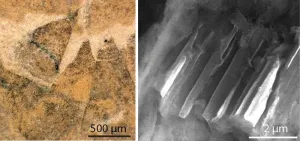(Press-News.org) UNIVERSITY PARK, Pa. — Snacks provide, on average, about one-fourth of most people’s daily calories. With nearly one in three adults in the United States overweight and more than two in five with obesity, according to the National Institutes of Health, researchers in the Penn State Sensory Evaluation Center are investigating how Americans can snack smarter.
The latest study conducted in the center, housed in the College of Agricultural Sciences, investigated how eating behavior changes when consumers are served a dip with a salty snack. The findings, available online now and to be published in the November issue of Food Quality and Preference, suggest that they eat more — a lot more. The chips and dip together yielded a 77% greater caloric intake, and a faster total eating rate compared to the just chips, no-dip control.
However, there was no difference in chip intake, pointed out study corresponding author John Hayes, professor of food science and director of the Penn State Sensory Evaluation Center.
“The most striking findings of our study is that people didn't eat fewer chips when dip was available — they ate the same amount of chips, plus the dip," he said. “This lack of compensation means that adding dip to chips can substantially increase overall energy intake without people realizing it.”
Intuitively, many people would guess that if we add something extra to a snack, like dip, people will compensate, and eat less of the main item, Hayes explained.
“But our research shows this is not the case with chips and dip,” he said. “Our participants consumed the same amount of chips regardless of whether dip was present, leading to much greater energy intake when dip was available.”
The study, which was led by research assistant Madeline Harper, who recently graduated from Penn State with a master’s degree in food science, assessed 46 adult participants. In two visits to the Sensory Evaluation Center, they were served 70 grams of ranch-flavored chips, or about 2.5 servings, with or without about a third of a cup of ranch dip. Participants ate as much as they wanted.
Their intake was measured, and all eating sessions were video recorded and annotated for number of bites and active eating time. Researchers used that information to calculate measures of “eating microstructure,” including eating rate and bite size.
Harper suggested that the greater intake of the chips and dip snack was facilitated by a larger bite size resulting from dip inclusion. On average per eating session, participants consumed 345 calories of chips and dip compared to 195 calories of chips alone.
The study was novel, Harper noted, because little research has been conducted on the effect of external sources of oral lubrication like dips on oral processing of salty snacks.
“Clearly, it has an influence on food intake, especially while snacking,” she said. “However, in this chips-and-dip snack, the greater intake resulting from dip inclusion may have been facilitated by a larger total snack bite size, as opposed to faster chip eating rate.”
Even though snacking is a major source of energy in the typical American diet, it remains understudied, Hayes said, adding that understanding eating behavior around snacking is crucial to address issues of overeating and obesity.
"This research opens up new avenues for exploring how the physical properties of foods can influence our eating behaviors and ultimately, our energy intake,” he said. “If we can slow people down, we can influence energy consumption without giving up the pleasure from food.”
Paige Cunningham, postdoctoral scholar in the Department of Food Science and the Department of Nutritional Sciences at Penn State, contributed to the research.
The U.S. Department of Agriculture’s National Institute of Food and Agriculture supported this research.
END
Trying to limit calories? Skip the dip, researchers advise
Serving a dip with a salty snack greatly promotes calorie intake in study
2024-08-01
ELSE PRESS RELEASES FROM THIS DATE:
Innovation Crossroads welcomes seven entrepreneurs for Cohort 2024
2024-08-01
Seven entrepreneurs comprise the next cohort of Innovation Crossroads, a Department of Energy Lab-Embedded Entrepreneurship Program node based at Oak Ridge National Laboratory. The program provides energy-related startup founders from across the nation with access to ORNL’s unique scientific resources and capabilities, as well as connect them with experts, mentors and networks to accelerate their efforts to take their world-changing ideas to the marketplace.
“Supporting the next generation of entrepreneurs is part of ORNL’s ...
American College of Rheumatology opens press registration for ACR Convergence 2024
2024-08-01
FOR IMMEDIATE RELEASE
Aug. 1, 2024
Media Contact:
Monica McDonald
(404) 365-2162
mmcdonald@rheumatology.org
American College of Rheumatology Opens Press Registration for ACR Convergence 2024
ATLANTA – Complimentary press registration is now open for journalists to cover research presented at ACR Convergence 2024, taking place Nov. 14-19 at the Walter E. Washington Convention Center in Washington, D.C. A listing of sessions for the meeting can be found in the online program.
Approved ...
Half a billion-year-old spiny slug reveals the origins of mollusks
2024-08-01
UNDER EMBARGO UNTIL 19:00 BST / 14:00 ET THURSDAY 1 AUGUST 2024
Images available via link in the notes section
Exceptional fossils with preserved soft parts reveal that the earliest molluscs were flat, armoured slugs without shells.
The new species, Shishania aculeata was covered with hollow, organic, cone-shaped spines.
The fossils preserve exceptionally rare detailed features which reveal that these spines were produced using a sophisticated secretion system that is shared with annelids (earthworms and relatives).
A team of researchers including scientists from the University of Oxford have made an astonishing discovery of ...
Award-winning research maps the body’s internal sensory communication highway
2024-08-01
When the question is “how are you feeling on the inside?,” it’s our vagus nerve that offers the answer.
But how does the body’s longest cranial nerve, running from brain to large intestine, encodes sensory information from the visceral organs? For his work investigating and mapping this internal information highway, Qiancheng Zhao is the 2024 grand prize winner of the Science & PINS Prize for Neuromodulation.
Interoception—the body’s ability to sense its internal state in a timely and precise manner—facilitated by the vagus plays a key role in respiratory, gastrointestinal, cardiovascular, endocrine and immune ...
Current Andean glacier loss is unprecedented in the Holocene
2024-08-01
Andean tropical glaciers are experiencing unprecedented retreat, according to a new study that reveals their current sizes are the smallest in over 11,700 years. “Our finding … identifies this region as a hot spot in our understanding of the changing state of the cryosphere,” say the authors. Glaciers act as important indicators of climate change, with their global retreat accelerating over recent decades. Examining this retreat in the context of the previous 11,700 years of the Holocene interglacial highlights the impact of modern global warming. Although many glaciers worldwide are smaller today compared to ...
New fossil resembling a bristly durian fruit reveals insights into the origin of molluscan skeletons
2024-08-01
The early evolution of mollusks has been hard to pin down, but now a newly discovered fossil – of a shell-less, soft-bodied, spiny mollusk from the early Cambrian – provides crucial insights, researchers report. The findings suggest that this fossil, of a creature called Shishania aculeata, is a stem mollusk – representative of an intermediate between early members of the superphylum lophotrochozoans and more derived mollusks. Mollusks are one of the most diverse groups of animals, encompassing various well-known forms such as clams, ...
CLEAR: a new approach to 3D printing materials with highly entangled polymer networks
2024-08-01
Researchers have developed a novel approach to three-dimensional (3D) printing they call “CLEAR,” which significantly improves the strength and durability of materials by using a combination of light and dark chemical reactions to create densely entangled polymer chains. The authors used their approach to print structures with special features, such as the ability to adhere to wet tissues. Incorporation of polymer chain entanglements as reinforcements within 3D printed materials can significantly enhance their mechanical properties. However, traditional vat photopolymerization-based 3D printing techniques, such as digital ...
Genetic insights into how prickles develop across different plants, despite evolutionary separation
2024-08-01
The evolutionary gain and loss of plant prickles – sharp pointed epidermal outgrowths – are controlled by a shared genetic program involving cytokinin biosynthesis, researchers report. The study sheds light on the genetic basis of the emergence of similar traits in distantly related organisms and reveals genomic targets for prickle removal for crop improvement. The genetic basis of trait convergence is a central question in evolutionary biology, and the extent to which it is driven by ...
Climate anomalies may play a major role in driving cholera pandemics
2024-08-01
New research suggests that an El Niño event may have aided the establishment and spread of a novel cholera strain during an early 20th-century pandemic, supporting the idea that climate anomalies could create opportunities for the emergence of new cholera strains. Xavier Rodo of Instituto de Salud Global de Barcelona, Spain, and colleagues present these findings in the open-access journal PLOS Neglected Tropical Diseases.
Since 1961, more than 1 million people worldwide have died in an ongoing cholera pandemic, the seventh cholera ...
Study shows link between asymmetric polar ice sheet evolution and global climate
2024-08-01
Recent joint research led by Professor AN Zhisheng from the Institute of Earth Environment of the Chinese Academy of Sciences has revealed the pivotal role of the growth of the Antarctic ice sheet and associated Southern Hemisphere sea ice expansion in triggering the mid-Pleistocene climate transition (MPT). It has also shown how asymmetric polar ice sheet evolution affects global climate.
The MPT refers to a shift in Earth’s climate system between about ~1.25–0.7 million years ago, marking a shift to more pronounced and regular ...
LAST 30 PRESS RELEASES:
Autonomous AI agents developed to detect early signs of cognitive decline
Study finds ocean impacts nearly double economic cost of climate change
Increased deciduous tree dominance reduces wildfire carbon losses in boreal forests
Researchers discover how a respiratory bacterium obtains essential lipids from the human body and targets fat-rich tissues
Locust swarms destroy crops. Scientists found a way to stop that
More resources and collaboration needed to support prevention and treatment of obesity
Two types of underconfidence linked to anxiety and gender
Insects are victims too: Global study shows impacts of invasive alien species on populations
Pioneering natural, degradable polymer capsules
Forestry is becoming digital and automated
Maternity baby deaths much higher in northern England than in the South
Mosquitoes’ thirst for human blood has increased as biodiversity loss worsens
The stop-smoking medication varenicline may also work for cannabis use disorder
Potential new treatment for sepsis
Study reveals how many hours of video games per week might be too many
Electrospinning for mimicking bioelectric microenvironment in tissue regeneration
Home fingertip oxygen monitors less accurate for people with darker skin tones
Six weeks in a cast no less effective than surgery for unstable ankle fractures
Precautionary approach to alcohol-free and low alcohol drinks needed to protect public health, say experts
Gas-atomized Ca–Mg alloy powders produce hydrogen simply by adding water — high-efficiency hydrogen generation at room temperature
British redcoat’s lost memoir reveals harsh realities of life as a disabled veteran
World-leading rare earth magnet recycling facility launches in UK
Corday Selden selected for the Oceanography Society Early Career Award
MIT chemists determine the structure of the fuzzy coat that surrounds Tau proteins
Same moves, different terrain: How bacteria navigate complex environments without changing their playbook
Severe weather is deadly for vulnerable older adults long after the storm ends, study finds
Expert panel highlights opportunities for improving cancer studies
Hearing aid prescriptions not associated with changes in memory and thinking
Seth Zippel selected for The Oceanography Society Early Career Award
Jeremy Horowitz selected for The Oceanography Society Early Career Award
[Press-News.org] Trying to limit calories? Skip the dip, researchers adviseServing a dip with a salty snack greatly promotes calorie intake in study





